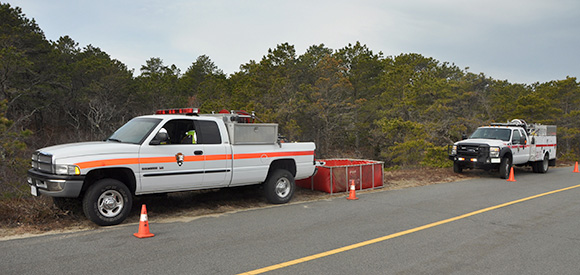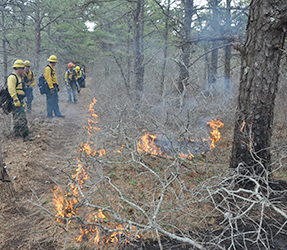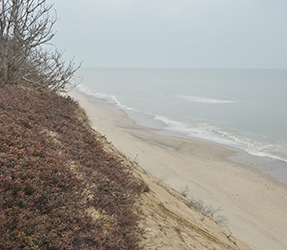Cape Cod National Seashore implemented a prescribed burn in the Marconi Wildlife Management Area in April 2014. The fire reduced fuels, restored ecosystem health, and promoted native habitats. Heathland communities are among the highest priorities for conservation in the Northeast because they support unique plants and animals. These communities are rapidly disappearing due to development and forest succession facilitated in part by fire suppression.
“Prescribed fire is an integral tool in managing landscapes. Judicious burning reproduces natural disturbances to keep the environment on the Cape healthy.” Bob Cook, NPS wildlife ecologist

NPS / B. Dougan
Restoring Wildlife Habitat

NPS / B. Dougan
Cape Cod National Seashore successfully implemented a 168-acre prescribed burn in the Marconi Wildlife Management Area in Wellfleet during April 2014. The area was burned as a first step toward restoring native heathlands affected in part by atmospheric nitrogen deposition. The fire reduced fuels, restored ecosystem health, and promoted native habitats as directed in the Final Environmental Impact Statement for the Cape Cod National Seashore hunting program. Heathland communities are among the highest priorities for conservation in the Northeast because they support a unique flora and the greatest concentration of rare or uncommon upland plant and animal species in the region. These communities are rapidly disappearing due to development and forest succession facilitated in part by fire suppression.
The unit had not been burned, with either wildfire or prescribed fire, in more than 60 years. The mean fire return interval for the area is six to ten years (Mass GIS, Landfire data). Three days of black-lining totaling 56 acres improved the wood road control lines for the 111-acre event on April 14. The burn met the objectives of consuming 90 percent of the forest floor litter layer, top-killing 70 percent of the understory vegetation, and reducing accumulation of dead and down 1- and 10-hour fuels by 50 percent while affecting less than 5 percent of the overstory and limiting scorch height to 8 meters.
Keep the Cape Healthy

NPS / B. Dougan
Bob Cook, a wildlife ecologist with the national seashore, commented, “Prescribed fire is an integral tool in managing landscapes. Judicious burning reproduces natural disturbances to keep the environment on the Cape healthy. In the past, natural forces such as fire caused patches of young forest and shrubland to move around on the landscape. Many native animals need heathland, shrubland, and young forest. Woodcock and whip-poor-wills use these semiopen areas for courtship. Box turtles shift back and forth between open and wooded habitats. They hibernate during winter by digging themselves down into the soil in areas with thick leaf litter and organic matter. Then in the summer, they lay their eggs in nests that they dig in open areas where the sun can reach the ground: the warmer soil in those places incubates the eggs until they hatch.”
Cook noted that prescribed burning helps other grassland and heathland wildlife, including Eastern meadowlarks, bobolinks, grasshopper sparrows, vesper sparrows, and small mammals such as meadow voles and meadow jumping mice, which are important prey for hawks, owls, and small carnivores. Many kinds of butterflies, moths, and other insects depend on open or young forest habitats and are not found in mature woods.
The seashore is planning another 100-plus-acre burn next spring in a unit directly south of the area just treated. Other areas planned for burning in the seashore this season include Fort Hill, Doane Rock, Griffin Island, the former MITRE site, and Pilgrim Springs. These burns will meet similar resource and fuel reduction goals.
Contact: David Crary Jr, Fire Management Officer, Cape Cod National Seashore
Email: e-mail us
Phone: (508) 957-0716
Last updated: December 14, 2017
